Physical Address
304 North Cardinal St.
Dorchester Center, MA 02124
This chapter focuses on high-energy injuries to the chest wall in the setting of major trauma, although fragility rib fractures are gaining increased attention in contemporary medicine. In 2004, there were 102,000 patients admitted to US hospitals and over 300,000 people treated for rib fractures in the United States. The true incidence is certainly higher than this estimate because the denominator is not known, particularly in light of the increasing incidence of fragility fractures. Rib fractures are detected in up to 39% (548 of 1417) of patients sustaining blunt chest trauma and up to 10% (711 of 7147) of all trauma admissions. Flail chest has been reported in up to 6% (82 of 1417) of patients with blunt chest trauma. Increased morbidity and mortality are recognized in patients with consecutively broken ribs. Patients sustaining three or more rib fractures have a markedly increased risk of pulmonary complications, including pneumothorax, hemothorax, and pulmonary contusion, and having bilateral rib fractures is associated with a 100% pulmonary complication rate. An in-hospital mortality rate of up to 12% (84 of 711) has been reported in patients with multiple rib fractures and up to 33% (30 of 92) in patients with flail chest. In older patients with blunt trauma, sustaining 5 or more rib fractures is associated with increased risk for admission to the intensive care unit (ICU), and 8 or more rib fractures is associated with increased mortality (odds ratio 1.51) and duration of mechanical ventilation. A survey of the National Trauma Data Bank confirmed these points in a cohort of 3457 patients with flail chest injuries, finding that 54% of patients with flail chest also experienced lung contusions, and 59% required mechanical ventilation for a mean of 12.1 days. Complications of pneumonia (16%), adult respiratory distress syndrome (14%), sepsis (7%), and death (16%) were key findings in this survey.
Major trauma with chest wall injuries has been shown to negatively affect patients’ quality of life. Prolonged chest wall pain and disability are common, with reported incidences of 59% and 76%, respectively, at 2 months after injury. A retrospective review of 397 trauma patients with chest wall injuries revealed markedly lower Short Form-12 (SF-12) and Glasgow Outcome Scale–Extended scores compared with published norms 2 years after injury. The authors also reported poor return-to-work rates, with 29% of patients not having returned to any work within 24 months after their injury. In Landercasper and colleagues’ cohort of patients with flail chest injuries treated nonoperatively, 49% continued to report chest pain, 39% experienced significant changes in their activity level, and 70% had abnormal pulmonary function test (PFT) measures at 12 months after injury.
In a survey published in 2009, Mayberry and colleagues reported, in a poll of 238 members of the Eastern Association for Surgery of Trauma, that 82% of general surgeons, 66% of orthopaedic surgeons, and 71% of thoracic surgeons believed that operative repair of rib fractures was indicated in select patients, but only 21% of trauma surgeons, 16% of orthopaedic surgeons, and 52% of thoracic surgeons indicated they had ever performed or assisted with open reduction and internal fixation (ORIF) of rib fractures. Despite this low experience, 33% (79 of 238) of trauma surgeons, 48% (47 of 97) of orthopaedic trauma surgeons, and 91% (64 of 70) of thoracic surgeons considered themselves competent to perform the surgery.
The topic of management of chest wall trauma is becoming increasingly relevant as more surgeons acquire the expertise to approach this clinical condition surgically and our understanding of operative indications improves. North American courses focused on the treatment of chest wall trauma have expanded, and increased interest has been seen in recent years. Interestingly, the vast majority of participants in rib fixation courses are general surgeons and thoracic surgeons, with orthopaedic surgeons representing only 10% of all enrollees according to a recent industry sponsor of courses on rib fracture fixation. Further, a number of randomized controlled trials evaluating the role of rib fixation are under way and expected to be completed over the next several years. A Canadian lead prospective, randomized, multicenter trial investigating the treatment of flail chest with and without surgery will conclude in 2018 and include over 200 patients ( ClinicalTrails.gov #NCT01367951). Another randomized control trial comparing operative versus nonoperative management of severe, non–flail rib fractures began recruitment in December 2017 and will enroll approximately 100 patients ( ClinicalTrails.gov #NCT03221595). To date, there are three published randomized controlled trials investigating the role of operative intervention on rib fracture, and these have unanimously favored fixation of flail chest injuries in patients requiring ventilatory support. Smaller trials and retrospective studies have further demonstrated that patients who underwent ORIF of flail chest injuries or multiple rib fractures required a shorter duration of ventilator support, were less likely to develop infections, and were less likely to require tracheostomy than patients managed nonoperatively. Despite these data, operative intervention remains controversial, and nonoperative care, even for the flail chest, continues to be the standard of care in most areas.
As surgeons continue to gain familiarity with the treatment of chest wall injuries and more research emerges, it is paramount that the orthopaedic trauma surgeon become aware of the short- and long-term sequelae of these injuries and the role surgery may have in improving outcomes. A collaborative approach between general or thoracic surgery and orthopaedic surgery is being held up as a new standard at leading Level I trauma centers around the country. It is mandatory that orthopaedic surgeons take center stage in the care of these injuries, given the required knowledge of principles of fracture fixation and fracture healing that are fundamental requisites to achieve optimal outcomes.
Rib fractures may be sustained from either penetrating insults or blunt trauma to the chest wall, with the vast majority being secondary to the latter by way of motor vehicle accidents (62%), followed by falls (22%). During a motor vehicle crash (MVC), rib fracture patterns are influenced by restraint status, the vector of impact, and occupant age. Interestingly, belted passengers and unbelted passengers sustain a similar number of mean rib fractures during a collision. Rib fractures in belted passengers tend to correspond to the beltline and are more lateral in location compared with unbelted passengers, whose fractures tend to be distributed evenly across the thorax. With regard to the vector of impact, nonfrontal impacts typically produce posterolateral rib fractures between ribs 7 through 11 on the impact side.
During an impact to the thorax, the load producing a rib fracture is a local bending and shearing that results in the typical short-oblique pattern seen on imaging. Direct, blunt trauma to the chest wall has the potential to produce a marked displacement of multiple rib and sternum fractures, leading to several important pathophysiologic consequences. First, the initial inward displacement of the fractured rib may produce a significant degree of thoracic and/or abdominal solid organ injury. In the thorax, as force is dissipated by the lung, marked increases in alveolar and parenchymal pressure result in mechanical tearing of tissue, and bone fragments contribute to direct laceration of the pleura and lung. These processes result in pulmonary contusions, pneumothoraces, and hemothoraces, which manifest clinically as an increased work of breathing, hypoxia, and hypercarbia. In the abdomen, the liver, spleen, and kidneys are most at risk, and injuries typically are seen with fractures involving ribs 5 through 12.
Flail chest is the result of three or more consecutive unilateral segmental rib fractures, three or more consecutive bilateral rib fractures, or three or more consecutive unilateral fractures associated with a fracture of the sternum ( Fig. 50.1 ). The physiologic consequence of this scenario is an uncoupling of the flail segment from the normal thoracic wall, resulting in a disruption of respiratory mechanics. Paradoxical movement is seen as the flail segment is drawn into the thoracic cavity with inspiration and pushed out with expiration, which is in contradistinction to the biomechanics seen in the intact rib cage ( Fig. 50.2 ). In the flail chest and during respiratory splinting secondary to multiple, severe rib fractures, the underlying portion of the lung remains atelectatic, resulting in poor oxygenation secondary to ventilation-perfusion mismatch and pneumonia secondary to stagnation of secretions.
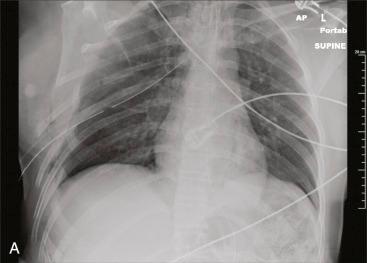
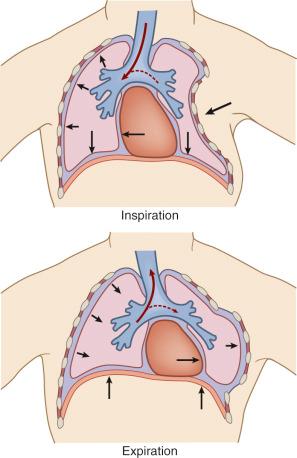
Pulmonary contusion resulting from chest wall trauma is an important entity deserving special recognition. The presence of pulmonary contusions in the setting of blunt thoracic trauma is high, with an incidence of 30% to 75%. Lung contusion results in decreased lung compliance, pulmonary shunting, and ventilation-perfusion mismatch secondary to alveolar hemorrhage, edema, and atelectasis, with the pathophysiologic consequence exacerbating the respiratory insufficiency seen in the setting of chest wall fractures. The full clinical manifestation may not declare itself immediately after injury but typically will come to fruition within 12 to 48 hours of injury and tends to resolve over the subsequent 5 to 7 days. In the setting of a chest wall fracture, the presence of an associated pulmonary contusion markedly increases the risk of requiring intubation (20% to 50%) and mortality (6% to 42%). Late complications of pulmonary contusions include lung fibrosis resulting in long-term derangements of pulmonary function.
Evaluation optimally begins in the emergency room setting after assessment of the injured patient's airway and breathing, coincident with a screening chest radiograph based on the mechanism of injury. Alternatively, consultations may be initiated for splinting and chest pain after blunt trauma in the setting of occult or missed rib fractures or the interpretation of computed tomography (CT) scans often obtained as a part of the standardized workup of trauma patients.
The physical examination should begin with a visual inspection of the thorax, looking for ecchymosis, lacerations, evidence of open fractures, and gross anatomic deformity of the rib cage and noting any wall incompetence manifested by paradoxical respiratory movement ( Fig. 50.3 ). The chest wall is palpated from posterolateral to the anterior midline to detect focal tenderness in the awake patient. Localized thoracic pain should then be correlated with findings on a chest radiograph. In the intubated patient, finer discernment for either bony or soft tissue crepitus is necessary. In the patient with multiple fractured and displaced ribs and a pneumothorax, soft tissue crepitus may feel like squeezing popcorn or soft bubble wrap, and often this condition ascends the neck. Tracheal deviation and distended or flattened neck veins may accompany a tension pneumothorax and require urgent decompression. Percussion of the chest may help identify a pneumothorax with hyperresonance or a hemothorax with dullness to percussion. Careful attention should be paid to the patient's respiratory effort, noting wheezing, stridor, and any increased work of breathing that will manifest as tachypnea and recruitment of accessory respiratory muscles. Vitals signs should be evaluated with scrutiny, and continuous monitoring of the patient's oxygenation should be routine.
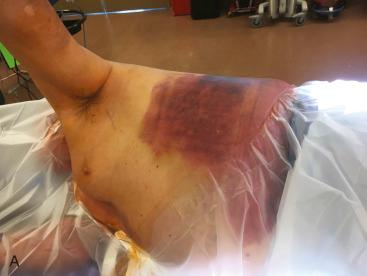
A routine chest radiograph should be obtained in any patient presenting with point tenderness along the chest wall after trauma. Plain radiographs have been repeatedly demonstrated in the literature to have poor diagnostic sensitivity for identifying rib fractures and in polytrauma, having a miss rate of over 50%. Oblique radiographs or rib views may increase the sensitivity if fractures are not found on a routine chest radiograph. Signs of subcutaneous air can easily be detected on a chest radiograph ( Fig. 50.4 ) and should tip off the examiner to a pneumothorax requiring chest tube placement. CT scans, which are now a routine part of the trauma workup, have been shown to have sensitivities greater than 95% and specificities greater than 99% for the diagnosis of thoracic cage fractures and have the advantage of identifying other occult thoracic injuries. In a recent retrospective study by Pulley and colleagues, two-dimensional (2-D) CT scans found an average of eight more rib fractures than chest radiographs and four more than three-dimensional (3-D) CT in polytraumatized patients with chest wall injuries. This study did note that upon review of 3-D CT scans, the traumatologist's surgical plan changed in 66% of cases. Thus 2-D CT should be the test of choice for the diagnosis of chest wall injuries in the traumatized patient, and 3-D reconstructions ( Fig. 50.5 ) should be performed as part of the preoperative planning process if operative intervention is being considered.
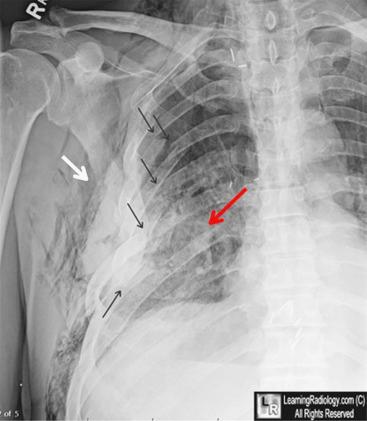
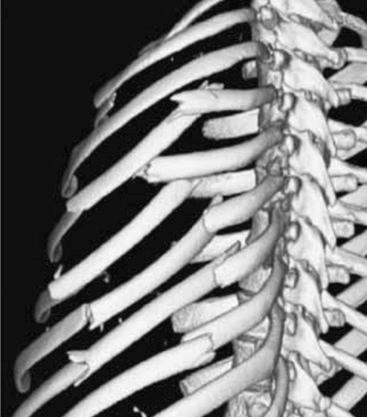
Although there is no specific classification for rib fractures, the term flail chest warrants understanding. The most commonly cited definition is the presence of four consecutive, unilateral ribs fractured in at least two places. Others have used three consecutive segmental rib fractures as a cutoff. A flail segment may also result from three consecutive unilateral rib fractures with an associated unstable sternal fracture or three consecutive bilateral rib fractures that produce an unstable wall segment. A sternal flail occurs when the sternum dissociates from the hemithoraces due to bilateral, multiple, anterior cartilage or rib fractures.
The RibScore has been proposed to quantify the severity of a chest wall injury, with a specific emphasis on the anatomic patterns of rib fractures ( Box 50.1 ). Using radiographic variables, a score is assigned from 0 to 6; the score has been demonstrated to correlate well with pulmonary complications such as pneumonia, acute respiratory failure, and need for tracheostomy. These authors recommended that patients with a score 4 or more be considered for operative fixation of chest wall fractures.
One point assigned for each of the following risk factors:
Six or more ribs fractured
Bilateral rib fractures
Flail chest
Three or more severely displaced fractures
First rib fracture
At least one fracture in each of three anatomic regions (anterior, lateral, and posterior)
The spectrum of injury between the patient with isolated rib fractures and the polytraumatized patient with a flail chest and fractured sternum varies, and management ranges from analgesics and respiratory toilet to intercostal nerve blocks, chest tube management, and ORIF of the patient with paradoxical motion during respiration. Having an understanding of how these management tools can be best applied to your patient may decrease and shorten the term of morbidity.
Several studies have found a direct correlation between the number of rib fractures and intrathoracic injury, morbidity, and mortality. A study of 105,683 trauma patients found that the presence of three or more rib fractures increased the relative risk of splenic injury to 6.2 and liver injury to 3.6. Up to 55% (391 of 711) of the patients with rib fractures have been found to require immediate operative intervention or admission to the ICU, where they can be closely monitored and/or supported with a ventilator. The initial management of patients should follow the Advanced Trauma Life Support (ATLS) algorithm. Patients with respiratory dysfunction or signs of hypoxemia should undergo rapid sequence intubation to gain control of respiration and facilitate further workup and definitive management. Emergent treatment of a chest wall injury associated with a pneumothorax or hemothorax should have an expeditious tube thoracostomy for drainage and management of the pleural cavity.
A low threshold should be maintained for intubation in the patient with a compromised respiratory status to stabilize the patient and facilitate a thorough trauma workup. Once the initial evaluation is complete and emergent interventions are completed, the decision must be made whether or not to continue ventilatory support. Obligatory mechanical ventilation for the management of severe rib fractures or flail chest may be harmful. Current guidelines now include the use of mechanical ventilation specifically to correct abnormalities in gas exchange; however, these patients should be weaned off as early as possible. There is no role for using mechanical ventilation to overcome chest wall instability in the setting of normal oxygenation and blood gas parameters.
The vast majority of rib fractures are appropriate for nonoperative treatment, with pulmonary toilet and pain control being the mainstay of treatment. For the vast majority of rib fractures, healing usually occurs spontaneously, and most patients are comfortable within weeks, particularly if the fractures are not associated with significant deformation of the chest wall. In its early course, nonoperative management of rib fractures is associated with substantial pain and discomfort as continued motion at the fracture sites occurs during breathing cycles. Although this rarely leads to symptomatic malunion or nonunion requiring operative intervention, it does pose the challenge of pain control during the healing phase.
Pain management is a key component of treatment because poor pulmonary hygiene secondary to pain intolerance is the major contributing factor to the development of pneumonia. Modalities for pain control include conventional oral analgesia (Tylenol, nonsteroidal antiinflammatory drugs [NSAIDs], gabapentin, diazepam, oxycodone), intercostal blocks, patient-controlled analgesia system (PCAS), pleural infusion catheters, and epidural analgesia. The use of narcotics should be minimized as able given their association with respiratory depression. Anecdotal evidence once suggested that topical lidocaine was beneficial in managing rib fracture pain; however, a recent randomized, double-blinded, placebo-controlled trial failed to demonstrate any significant improvement of pain symptoms with lidocaine patches compared with placebo. Ketorolac use in the acute setting for pain relief has been demonstrated to offer improved pain control and decrease the incidence of pneumonia in one study cohort. Methocarbamol has also recently been demonstrated to improve pain control by reducing intercostal spasms and may decrease the length of hospital stay. Epidural analgesia, although not employed with great frequency, is an excellent modality for pain control and has been associated with a reduction in mortality in patients sustaining multiple rib fractures.
Once chest wall pain is under control, maintenance of the pulmonary toilet should be the major focus of treatment, and the patient should be counseled on the importance of this. Patients should be trained on the proper use of the incentive spirometer and frequent and regular use encouraged. Deep-breathing exercises, coughing, and regular ambulation if possible will further work to optimize pulmonary hygiene and function. Upon discharge, the patient should be given an incentive spirometer to take home and a successful plan for pain management.
Become a Clinical Tree membership for Full access and enjoy Unlimited articles
If you are a member. Log in here